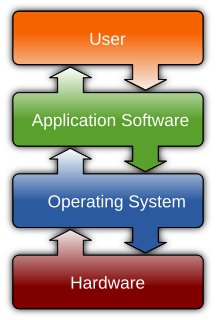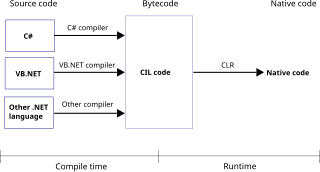
Computer software, or simply software, is a collection of data or computer instructions that tell the computer how to work. This is in contrast to physical hardware, from which the system is built and actually performs the work. In computer science and software engineering, computer software is all information processed by computer systems, programs and data. Computer software includes computer programs, libraries and related non-executable data, such as online documentation or digital media. Computer hardware and software require each other and neither can be realistically used on its own.
Microsoft Windows is a group of several graphical operating system families, all of which are developed, marketed, and sold by Microsoft. Each family caters to a certain sector of the computing industry. Active Windows families include Windows NT and Windows Embedded; these may encompass subfamilies, e.g. Windows Embedded Compact or Windows Server. Defunct Windows families include Windows 9x, Windows Mobile and Windows Phone.

Microsoft Corporation (MS) is an American multinational technology company with headquarters in Redmond, Washington. It develops, manufactures, licenses, supports and sells computer software, consumer electronics, personal computers, and related services. Its best known software products are the Microsoft Windows line of operating systems, the Microsoft Office suite, and the Internet Explorer and Edge web browsers. Its flagship hardware products are the Xbox video game consoles and the Microsoft Surface lineup of touchscreen personal computers. As of 2016, it is the world's largest software maker by revenue, and one of the world's most valuable companies. The word "Microsoft" is a portmanteau of "microcomputer" and "software". Microsoft is ranked No. 30 in the 2018 Fortune 500 rankings of the largest United States corporations by total revenue.

The Common Language Runtime (CLR), the virtual machine component of Microsoft's .NET framework, manages the execution of .NET programs. Just-in-time compilation converts the managed code, into machine instructions which are then executed on the CPU of the computer. The CLR provides additional services including memory management, type safety, exception handling, garbage collection, security and thread management. All programs written for the .NET framework, regardless of programming language, are executed by the CLR. All versions of the .NET framework include CLR. The CLR team was started June 13, 1998.

MSN is a web portal and related collection of Internet services and apps for Windows and mobile devices, provided by Microsoft and launched on August 24, 1995, the same release date as Windows 95.

Visual Basic .NET (VB.NET) is a multi-paradigm, object-oriented programming language, implemented on the .NET Framework. Microsoft launched VB.NET in 2002 as the successor to its original Visual Basic language. Although the ".NET" portion of the name was dropped in 2005, this article uses "Visual Basic [.NET]" to refer to all Visual Basic languages released since 2002, in order to distinguish between them and the classic Visual Basic. Along with Visual C#, it is one of the two main languages targeting the .NET framework.

C# is a general-purpose, multi-paradigm programming language encompassing strong typing, lexically scoped, imperative, declarative, functional, generic, object-oriented (class-based), and component-oriented programming disciplines. It was developed around 2000 by Microsoft within its .NET initiative and later approved as a standard by Ecma (ECMA-334) and ISO. C# is one of the programming languages designed for the Common Language Infrastructure.
Yupi was a Spanish-language Internet portal founded in 1997 by Carlos Cardona, and Camilo Cruz in Miami Beach, Florida.
Qt Jambi is a Java binding of the cross-platform application framework Qt. It enables Java developers to use Qt within Java programming language. In addition, Qt Jambi generator can be used to create Java bindings for other Qt libraries and future versions of Qt. Unlike GTK there are no Swing LAF implementations that use Qt for rendering.
TypeScript is an open-source programming language developed and maintained by Microsoft. It is a strict syntactical superset of JavaScript, and adds optional static typing to the language.
IronRuby is an implementation of the Ruby programming language targeting Microsoft .NET framework. It is implemented on top of the Dynamic Language Runtime (DLR), a library running on top of the Common Language Infrastructure that provides dynamic typing and dynamic method dispatch, among other things, for dynamic languages.
Kodu, originally named Boku, is a programming integrated development environment (IDE) by Microsoft's FUSE Labs. It runs on Xbox 360 and Microsoft Windows XP, Windows Vista, Windows 7, Windows 8 and Windows 10. It was released on the Xbox Live Marketplace on June 30, 2009. A Windows version is available to the general public for download from Microsoft's FUSE web portal.

Microsoft Visual Studio is an integrated development environment (IDE) from Microsoft. It is used to develop computer programs, as well as websites, web apps, web services and mobile apps. Visual Studio uses Microsoft software development platforms such as Windows API, Windows Forms, Windows Presentation Foundation, Windows Store and Microsoft Silverlight. It can produce both native code and managed code.

Windows Server 2008 R2 is a server operating system produced by Microsoft. It was released to manufacturing on July 22, 2009 and became generally available on October 22, 2009.
Microsoft Azure is a cloud computing service created by Microsoft for building, testing, deploying, and managing applications and services through Microsoft-managed data centers. It provides software as a service (SaaS), platform as a service (PaaS) and infrastructure as a service (IaaS) and supports many different programming languages, tools and frameworks, including both Microsoft-specific and third-party software and systems.

Visual FoxPro is a discontinued Microsoft data-centric procedural programming language that subsequently became object-oriented.

.NET Framework is a software framework developed by Microsoft that runs primarily on Microsoft Windows. It includes a large class library named as Framework Class Library (FCL) and provides language interoperability across several programming languages. Programs written for .NET Framework execute in a software environment named the Common Language Runtime (CLR). The CLR is an application virtual machine that provides services such as security, memory management, and exception handling. As such, computer code written using .NET Framework is called "managed code". FCL and CLR together constitute the .NET Framework.
The Shared Source Initiative (SSI) is a source-available software licensing scheme launched by Microsoft in May 2001. The program includes a spectrum of technologies and licenses, and most of its source code offerings are available for download after eligibility criteria are met.
.NET Compiler Platform, also known by its nickname Roslyn, is a set of open-source compilers and code analysis APIs for C# and Visual Basic .NET languages from Microsoft.

Visual Studio Code is a source-code editor developed by Microsoft for Windows, Linux and macOS. It includes support for debugging, embedded Git control, syntax highlighting, intelligent code completion, snippets, and code refactoring. It is also customizable, so users can change the editor's theme, keyboard shortcuts, and preferences. The source code is free and open source and released under the permissive MIT License. The compiled binaries are freeware and free for private or commercial use.












